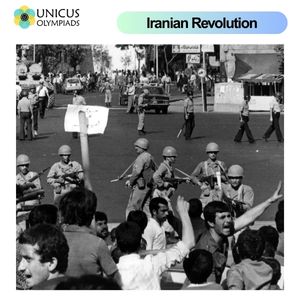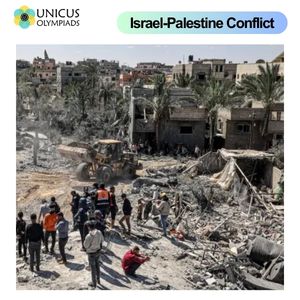What Are the Global Effects of Events Like the Iranian Revolution or the Israel-Palestine Conflict?
Major geopolitical events, such as the Iranian Revolution and the ongoing Israel-Palestine conflict, have far-reaching effects not only within the affected regions but across the globe. These conflicts shape international politics, security policies, economic trends, and cultural dynamics. The Iranian Revolution and the Israel-Palestine conflict are two such pivotal events in modern history, influencing global relations, particularly in the Middle East and beyond. This article explores the global effects of these events, examining their historical context, outcomes, and lasting impacts on the world stage.
1. The Iranian Revolution: A Shift in Middle Eastern Geopolitics
The Iranian Revolution, which took place in 1979, was one of the most significant political upheavals in the Middle East. It led to the overthrow of Iran's monarchy, under Shah Mohammad Reza Pahlavi, and the establishment of the Islamic Republic of Iran under Ayatollah Ruhollah Khomeini. This revolution fundamentally changed the political, social, and cultural landscape of Iran, as well as altering the dynamics of the region and the world. Its effects can still be felt today.

1.1 Key Events of the Iranian Revolution
- Overthrow of the Shah: In 1979, following years of political dissent, economic hardship, and opposition to the Shah’s regime, protests erupted across Iran. The Shah fled the country, and Ayatollah Khomeini, who had been exiled, returned to Iran and assumed leadership.
- Establishment of the Islamic Republic: The revolution resulted in the establishment of an Islamic theocracy, fundamentally changing Iran’s political system. Khomeini became the Supreme Leader, holding ultimate authority over both political and religious matters.
- Hostage Crisis: In November 1979, Iranian militants stormed the U.S. Embassy in Tehran and took 52 American diplomats hostage. The crisis lasted for 444 days, severely affecting U.S.-Iran relations and contributing to long-standing tensions between the two nations.
1.2 Global Effects of the Iranian Revolution
- Shifting Alliances in the Middle East: The Iranian Revolution marked a shift in Middle Eastern geopolitics. Iran, once a close ally of the United States, became an adversary and a key player in promoting Islamic fundamentalism. The revolution led to the rise of Iran as a regional power, competing with traditional U.S.-backed monarchies and regimes in the region, such as Saudi Arabia.
- Impact on U.S. Foreign Policy: The U.S. lost a key ally in the region, leading to the reorientation of U.S. foreign policy towards other countries, such as Iraq and Saudi Arabia. The hostage crisis was a critical event in this shift, with U.S. relations with Iran remaining hostile ever since.
- Rise of Islamic Fundamentalism: The success of the Iranian Revolution inspired Islamist movements across the Muslim world, particularly in countries with authoritarian governments. Iran’s Islamic Revolution served as a model for other movements in the Middle East and North Africa, such as Hezbollah in Lebanon and Hamas in Palestine.
- Oil Crisis and Economic Impact: The revolution contributed to the 1979 oil crisis, as oil prices surged due to instability in the region. The disruption of Iran’s oil exports affected global energy markets, leading to an economic downturn in many Western nations and increasing the price of oil worldwide.
1.3 Continuing Impact
The Iranian Revolution continues to shape global politics in several ways. Iran’s status as a regional power has led to frequent conflicts with neighboring countries, particularly regarding its nuclear program and involvement in regional conflicts such as those in Syria and Yemen. Additionally, Iran's support for various militant groups and its stance against U.S. and Israeli policies have made it a central figure in Middle Eastern politics and international relations.
2. The Israel-Palestine Conflict: A Persistent Source of Tension
The Israel-Palestine conflict is one of the longest-standing and most complex geopolitical conflicts in modern history. Rooted in competing nationalist, religious, and territorial claims, the conflict has had significant ramifications not only for the Middle East but for international relations, diplomacy, and security worldwide. The primary issue centers around the claim to land, with both Israelis and Palestinians asserting their right to live in the area known as historic Palestine, which includes the modern state of Israel, the West Bank, and Gaza Strip.

2.1 Key Events in the Israel-Palestine Conflict
- The Creation of Israel (1948): The establishment of Israel in 1948, following the end of British rule in Palestine and the subsequent United Nations partition plan, marked the beginning of the Israel-Palestine conflict. The declaration of the state of Israel was followed by the first Arab-Israeli war, in which neighboring Arab states attempted to prevent the creation of Israel, leading to the displacement of hundreds of thousands of Palestinians.
- The Six-Day War (1967): In 1967, Israel fought against Egypt, Syria, and Jordan in the Six-Day War, resulting in Israel’s occupation of the West Bank, Gaza Strip, and East Jerusalem. This occupation has been a central point of contention in the conflict, with Palestinians seeking the return of these territories.
- Oslo Accords (1993): In an attempt to resolve the conflict, the Oslo Accords were signed by Israel and the Palestine Liberation Organization (PLO) in 1993. The agreement established the Palestinian Authority and outlined a framework for a two-state solution. However, the peace process stalled, and violence between the two sides continued.
2.2 Global Effects of the Israel-Palestine Conflict
- Impact on Regional Stability: The Israel-Palestine conflict has been a primary source of instability in the Middle East for decades. It has fueled tensions between Israel and its Arab neighbors, particularly in wars such as the 1948 Arab-Israeli War, the Six-Day War, and the Yom Kippur War. The conflict has also contributed to the rise of extremist groups, such as Hamas in Gaza, which reject the existence of Israel.
- Role of the United States: The United States has played a central role in attempting to mediate peace between Israel and Palestine. U.S. support for Israel, both militarily and diplomatically, has been a major factor in the conflict. American efforts, including the Camp David Accords (1978) and the Oslo Accords (1993), were key moments in the peace process, although long-term resolution remains elusive.
- Internationalization of the Conflict: The Israel-Palestine conflict has attracted global attention and has been the focus of numerous international efforts for peace. The United Nations, the European Union, and the Arab League have all been involved in diplomatic initiatives. However, the conflict has also been a source of division, with various countries taking sides. For example, many Arab and Muslim-majority countries support the Palestinian cause, while Israel has strong alliances with Western countries, particularly the United States.
- Impact on Global Security: The Israel-Palestine conflict has been a central issue in global security discussions, particularly in the context of terrorism and radicalization. The ongoing violence and lack of resolution have contributed to the rise of militant groups like Hamas, Hezbollah, and Islamic Jihad, which have led to further instability in the Middle East.
2.3 Continuing Impact
The Israel-Palestine conflict continues to affect global diplomacy and international relations. Despite numerous peace efforts, including the U.S.-brokered Abraham Accords (2020) between Israel and the UAE and Bahrain, the conflict remains unresolved. The humanitarian situation in Gaza and the West Bank remains dire, and the ongoing violence between Israel and Palestinian factions exacerbates regional instability.
3. Comparisons and Broader Implications
Both the Iranian Revolution and the Israel-Palestine conflict have had profound and lasting global effects. While the Iranian Revolution was a national upheaval that transformed Iran’s political and social structures, the Israel-Palestine conflict is a long-running territorial dispute that has been a focal point of Middle Eastern and global politics for decades.
- Impact on Global Politics: Both events have shaped the foreign policies of global powers, with the U.S. and Western nations supporting Israel and viewing Iran as a regional adversary. Conversely, many Arab and Muslim-majority countries support the Palestinian cause and view Iran as a key ally in the region.
- Influence on Extremism: Both events have contributed to the rise of extremist groups. The Iranian Revolution gave rise to the Islamic Republic of Iran, which has been a key player in supporting groups like Hezbollah and Hamas. The Israel-Palestine conflict has led to the growth of militant groups like Hamas, which seeks to oppose Israeli occupation through armed resistance.
- Global Humanitarian Concerns: Both crises have resulted in significant human suffering, including mass displacement, loss of life, and widespread humanitarian needs. The international community continues to respond with humanitarian aid, peacekeeping efforts, and diplomatic initiatives to mitigate the impact on civilians.
4. Conclusion: The Long-Lasting Effects of the Iran-Ukraine and Israel-Palestine Conflicts
The Iran-Ukraine conflict, the Israel-Palestine conflict, and other geopolitical struggles in the Middle East continue to shape global politics, international security, and humanitarian aid. While these events have caused significant human suffering, they have also led to important changes in foreign policy, regional alliances, and global diplomacy. The effects of these conflicts will be felt for years to come, requiring sustained international cooperation, conflict resolution, and humanitarian efforts to foster peace and stability in the affected regions and beyond.



